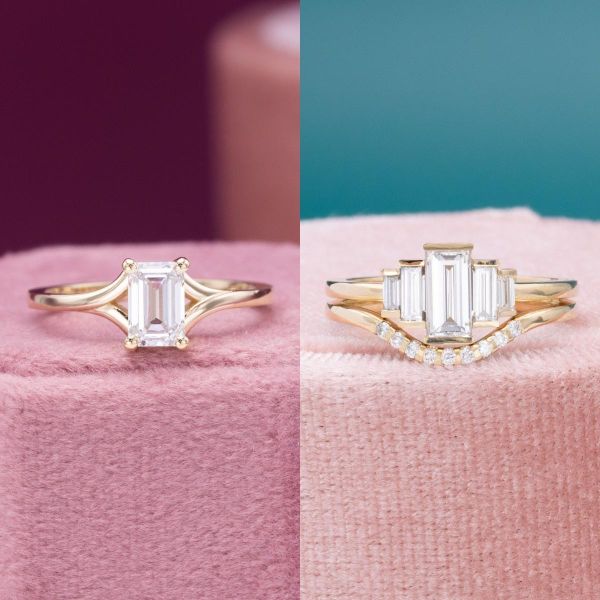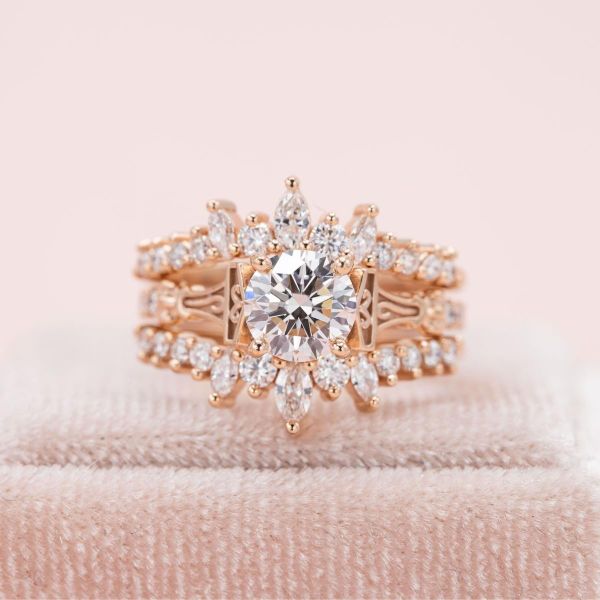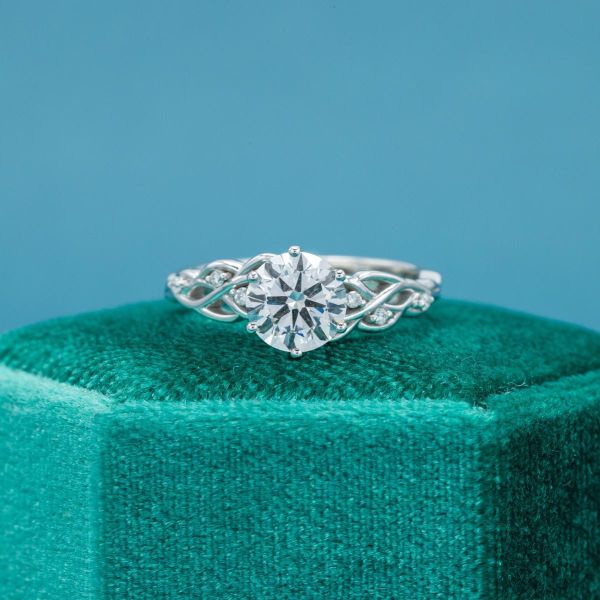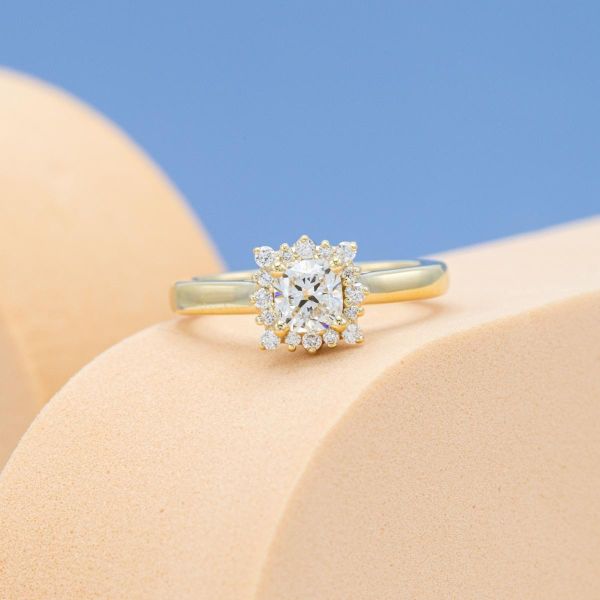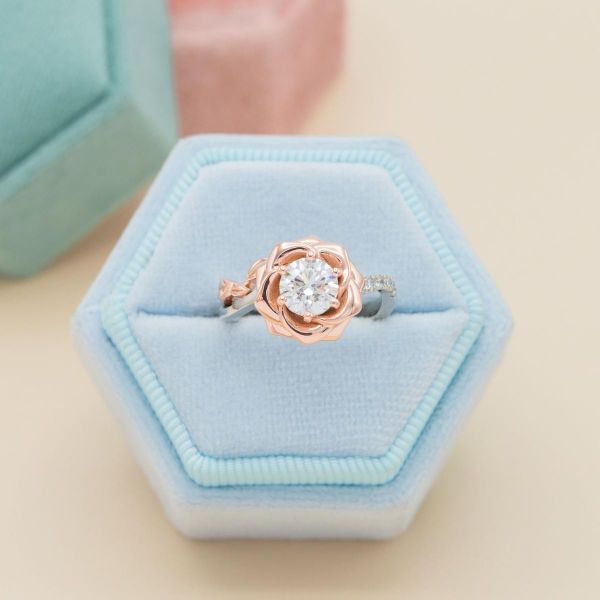Diamond Knowledge
Is lab diamond a good choice for an engagement ring?
Lab diamonds offer couples that signature diamond sparkle and durability along with ethical sourcing and long-term sustainability all at a reasonable price, but are they a good choice for engagement rings?
Choosing a lab diamond for your engagement ring: yes or no?
Should you choose a lab or natural diamond? It’s a question that many couples ask themselves when starting their search for the perfect engagement ring, and we know there can be a stigma around lab diamonds not being “real”.
But, in reality, lab diamonds are indistinguishable from natural stones, and they provide incredible beauty, durability, and sparkle at a fraction of the cost compared to their nature-made counterparts. They can be the common bright white or a multitude of colors, come in all shapes and sizes, and complement even the most intricate settings. But is a lab diamond the right stone for you? We're here to demystify lab diamonds and answer all of your questions about the man-made version of this stone. Let’s take a look at the finer points of lab diamonds and the top reasons to choose one for your engagement ring.
Reasons to choose lab diamonds
They’re (almost) exactly the same as natural diamonds
Lab diamonds are–as their name implies–diamonds. And why do people love diamonds? Do we really even have to ask? Like moths to a flame, many brides are immediately drawn to the sparkling, classic look of a diamond ring, and these stones have a colorless appeal that fits any aesthetic.
A diamond’s sparkle is iconic, so it’s no surprise that it continues to be the top choice for engagement rings! Faceters maximize a diamond’s fire, brilliance, and scintillation to create that swoon-worthy white sparkle with colorful flashes. Plus their orderly carbon structure is built to last forever, which is a lovely symbol for the enduring love and promise associated with marriage.
Lab diamonds are physically, chemically, and optically identical to natural ones, and many couples fall in love with lab diamonds for their identical sparkle, durability, and versatility. The easiest way to conceptualize lab and natural diamonds is to think of them as ice. Natural diamonds are like the ice on a pond, and lab diamonds are the ice in your freezer. They’re exactly the same thing, but one’s just easier to reach for when you want to make margaritas (or a diamond engagement ring)!
But if they're the same, why isn't everyone choosing a lab diamond? Different strokes for different folks, and for some it's less about the look of the stone but more so the meaning and where it came from. While some couples admire how experts can create high-quality lab diamonds in a controlled environment at a much faster pace, other couples find the complex journey of a natural diamond from Earth’s crust to their engagement ring rather romantic! In the end, choosing a lab or natural diamond is a personal choice.
Just for fun, see if you can spot the lab and natural diamonds. Spoiler alert: you won’t be able to tell the difference.
They’re reasonably affordable
While price may not matter to everyone looking for their dream diamond, it’s a big deal for those of us graduates still playing “Game of Loans”! A 1 carat lab diamond will cost roughly $450-$1,200, which means plenty of wiggle room for some serious ring upgrades. For comparison's sake, a similar natural diamond will cost you around $4,000-$9,000.
That’s right, opting for a lab diamond means you can upgrade your stone for less: enhancing the quality or size of your chosen diamond or adding more accent stones and design elements to your engagement ring on the same budget. Or, you could put that extra cash toward your venue, wedding bands, or even a dream honeymoon on a sandy beach (did someone say Bora Bora?!).
They’re extremely durable and scratch-resistant
“A diamond is forever”: we’ve all heard it before. And whether you buy into this famous marketing slogan or not, it’s true that diamonds are the cream of the crop in terms of durability. Lab diamonds are no exception, and these sturdy stones have a strong, uniform structure that’s built to last a lifetime.
Experts use the Mohs scale of hardness to grade a gemstone’s durability, and possible grades range from 0 (the most delicate) to 10 (the hardest). Lab diamonds are a perfect 10, which is ideal for those of us who can’t go through a regular work day without banging our rings on desks, doors, counter tops, etc.
Lab diamonds are also very scratch resistant, so they can safely handle the inevitable scrapes and scuffs that come with daily life. You should still take your lab diamond engagement ring for routine cleanings and inspections every 6 to 12 months, but otherwise your ring is set to sparkle for decades to come. Shine on, you crazy diamond!
You can choose from plenty of cuts, shapes, and sizes
Lab diamonds are available in almost any shape imaginable, and their colorless appearance means they look great in every brilliant, step, and mixed cut style you can think of. The most popular cut for lab diamonds is the round brilliant because it maximizes fire, brilliance, and scintillation (the building blocks of sparkle!). Its round shape also complements any finger or hand, making it a chameleon among diamond silhouettes.
But lab diamonds can bring that bright sparkle to any shape, and it really just depends on what type of sparkle and shape combination you love most. These lab diamonds may have different silhouettes, but just look at how each one has its own sparkling personality!
We already talked about upgrading the size of your lab diamond for less, but how big you want to go is really up to you and your budget. Lab diamonds can grow up to 10 carats, but most of us don’t want to carry around a rock that size all day. Most couples choose diamonds in the 1 to 3 carat range, so if you were thinking of a 1 carat solitaire, consider whether you might want to upgrade to a 2 or even 3 carat lab stone without breaking the bank.
They’re ethical and sustainable
Many couples look for more than just beauty and value when searching for an engagement stone: they want something sustainable and ethical that leaves Mother Earth exactly as we found her. Luckily, lab diamonds are an ethically sound and environmentally-friendly option for couples looking to limit their global impact!
Using less water and energy during production, lab diamonds are pretty eco-friendly, and they have a much smaller carbon footprint and offer more long-term sustainability. There’s also less need to worry about favorable working conditions for anyone involved in the production and sale of lab diamonds, so any concerns about human rights issues are non-existent. Lab diamonds take the stress out of choosing a sparkling stone for your engagement ring, and you can pick one without worrying about the environmental and ethical consequences.
They look amazing in any setting
The sky’s the limit when it comes to the imaginative settings you can create with lab diamonds. A diamond has a timeless sparkle that adapts to its surroundings, and lab diamonds look just as brilliant in intricate designs as they do in minimalist solitaire settings. Whether it’s a single diamond on a simple band or settings with pavé accents, halos, and side stones, lab diamonds never fail to get our hearts pumping with their glittering displays.
Lab diamonds are typically colorless, but experts can create them in just about any hue you can think of to match your ideal setting. They can even come in vibrant shades like pink, blue, yellow, and more for those who want to add a splash of color to their engagement ring design.
Their usual colorless appeal also means lab diamonds pair well with other colored gemstones, or you can match them with other white stones to amp up the Hollywood glam. Lab diamonds also make great accent stones, so you can create an engagement ring that gives the Crown Jewels a run for their money for a fraction of the cost!
What’s more, your lab diamond will reflect the color of the setting you choose. Diamonds are cut for maximum sparkle, and when set in cool metals like white gold and platinum diamonds with a high color grade take on an icy tone. But if you choose yellow or rose gold, the reflections from the metals will actually hide the diamond’s natural color, meaning you can choose a stone with a lower color grade and still achieve a colorless look.
Is a lab diamond right for you?
Lab diamonds are absolutely a great choice for engagement jewelry. In addition to having the timeless colorless look and bright sparkle brides are often drawn to, they’re sustainable and affordable on any budget. This means you can create the ring of your dreams without skimping on your reception, ceremony, or that lavish honeymoon to Bora Bora we already agreed on (please take us with you!). Reach out today if you’re ready to discuss how we can design the perfect lab diamond engagement ring for your needs!
About CustomMade
CustomMade designs and creates one-of-a-kind, custom engagement rings and fine jewelry. Each piece we create is inspired by you, designed for you, and made just for you.
